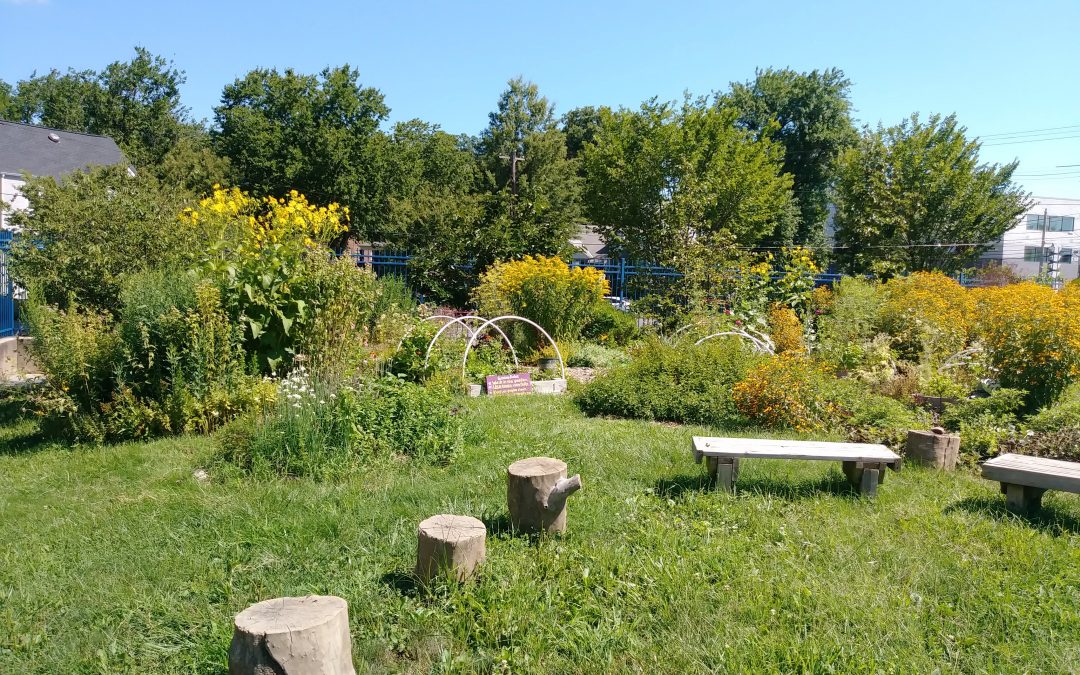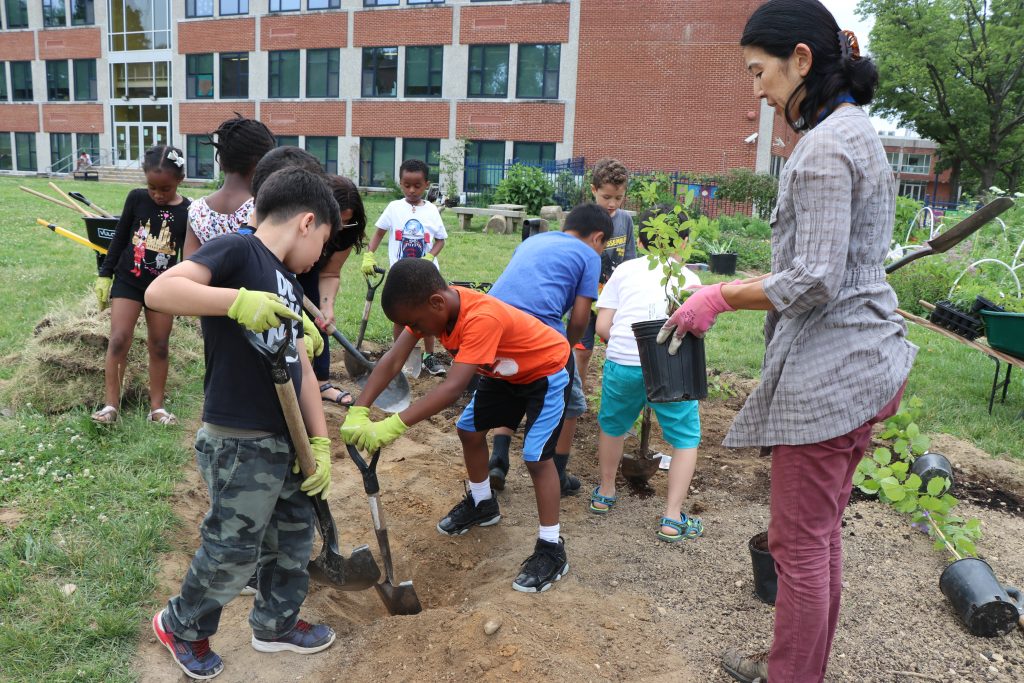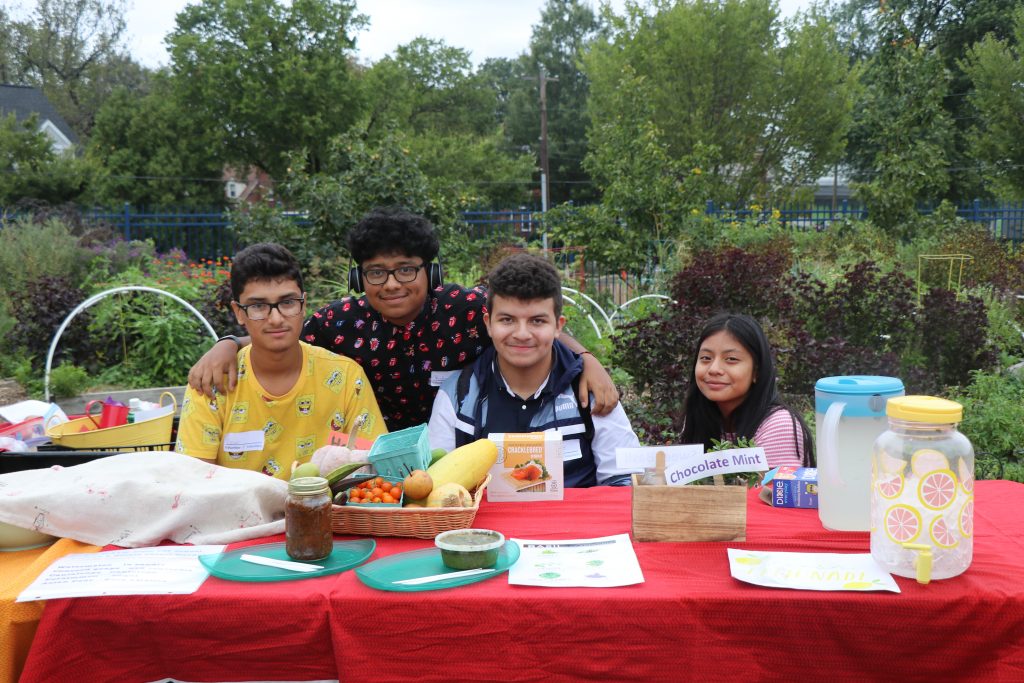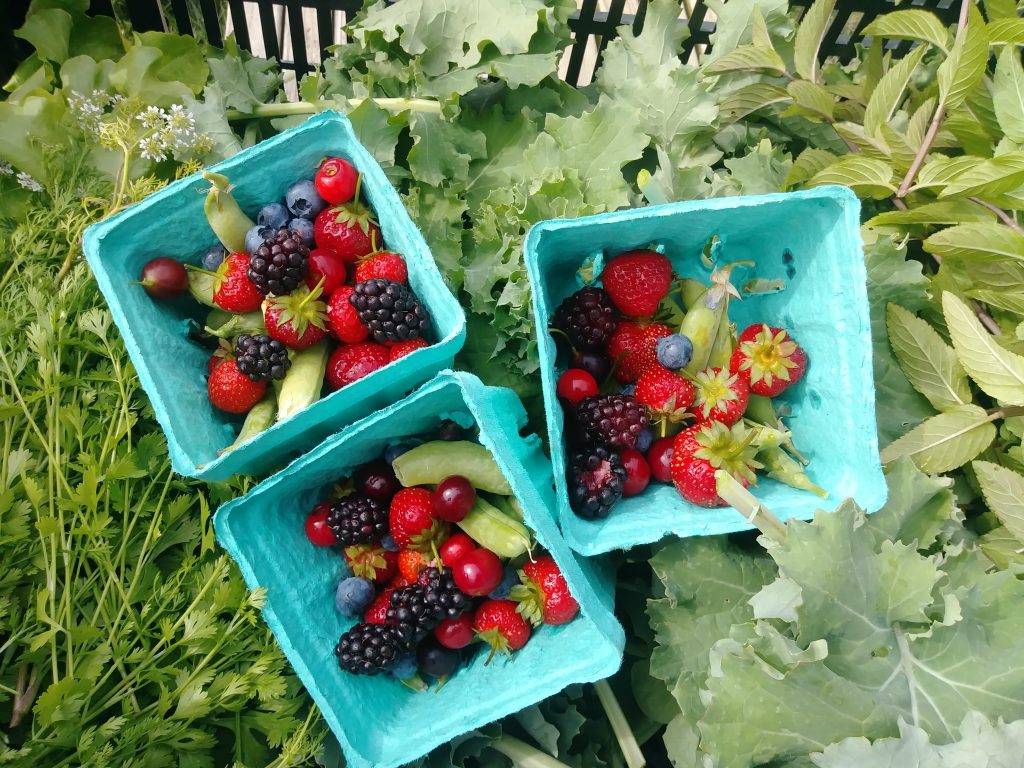By. Ryoko Yamamoto
School gardens are popping up at schools across the United States, and for good reason. These “outdoor classrooms” nourish students’ minds and bodies by serving up delicious produce for school meals and snacks, as well as lessons in math, science, social studies, and language arts. But have you ever heard of a forest garden? If not, allow me to let you in on a little secret that’s sprouting roots at Capital City Public Charter School (CCPCS) in Washington D.C.
CCPCS moved to its current location in Northwest Washington D.C. in 2012. Not long after the move, parent volunteers literally scratched the underserved grass field into a school garden with eight vegetable beds and a few trees. We added projects over the years thanks to grant funding and in-kind support from local partnerships. One of those projects was an Edible Forest Garden. Since 2017, we have worked with the District Department of Transportation’s Urban Forestry Division and Forested, LLC to plan and implement the Edible Forest Garden, which sits adjacent to our existing school garden and includes more than 1,000 trees, berries, shrubs, and multipurpose perennials. With the Edible Forest Garden, we aim to teach students about agroforestry and give them a glimpse of the complex symbiosis of a forest ecosystem.
A Missing Link Between Food and the Environment
The inspiration for the Edible Forest Garden and its mixed forest composition comes from my hometown in Japan. Tracing back to my childhood, it was normal to find perennial edible plants such as plum, persimmon, butterbur, ginger, myoga, and mum flower, to name a few, growing seasonally in our yard and on the small farms my grandparents tended. Bartering harvests within the community was a common, year-round custom, starting with early spring’s shoots of sansei greens and young bamboo and transitioning to full harvests of chestnuts, pears, and apples in the fall.
When I immigrated to the U.S. in 2005, the country’s collective awareness of climate change and the ensuing environmental crisis was still in its infancy. As a young mother, the missing link between food and the environment in my new home was unmistakable, from the artificially glossy apples and boxes of processed food in grocery stores to the lack of compost bins alongside trash cans and recycling bins. Even though I lived in New York City, a major urban center, I yearned to feed my child natural, unprocessed food. So, when I moved to Washington D.C., I was more than eager to start a small community garden with my neighbors. A few years later, I was one of the original CCPCS parent volunteers who pitched in to create a garden at the school. At the time, Michelle Obama was promoting the Let’s Move campaign and was tending to a kitchen garden at the White House. In planting the school garden, we wanted to capitalize on this moment and our proximity to the nation’s garden (just six miles away!) and give our students an opportunity to experience the joys of a harvest while helping them make the connection between soil and the table, and between nature and humans. The addition of a forest garden was a natural next step for me. I wanted students to have some of the same experiences I had as a child in Japan while showing them how a biodiverse landscape contributes to a sustainable world.
Connections to the Curriculum
During a typical school year, our school garden program engages students in lessons about our environment and healthy food options. As a PreK-12 EL Education school, we use a workshop model that incorporates fieldwork and community service into academics. The garden supports hands-on experiences that are part of class expeditions; for example, PreK students are introduced to the idea of where our food comes from by growing lettuce from seeds. They plant the seeds, observe their growth over six weeks, and taste a sweet leafy salad together through the Salad Science Program. Our first-grade students take part in a bee expedition, where they learn about bees and pollinators and become advocates for them. They observe bees in their natural habitat, learn about pollination, and realize bees are vital to our ability to grow food.
Curricular connections aren’t limited to elementary-age students. Our middle and high school students also benefit from expeditions tied to the school garden. One example involves our eleventh-grade Environmental Science class and their Food Justice expedition. Students collaborate with the University of the District of Columbia to advocate for a fair and sustainable food system by researching topics related to food policy, school lunches, recycling, and food sovereignty. They also run the School Garden Market (a version of a farmers’ market), where they educate families about seasonal and local food options while brewing herbal lemonade and serving cut fruit and vegetable samples and healthy snacks like kale chips and garlic chive spread.
Our forest garden curriculum is still a work in progress, specifically our focus on agroforestry and nutrition-related lessons. I envision one day teaching students how to cook recipes using ingredients like acorns and mushrooms during units focused on Indigenous peoples. Currently, we are using the forest garden to teach elementary science lessons, such as comparing the soil food webs found in grassland and forest habitats. Middle and high school lessons examine the forest carbon cycle, which plays a role in mitigating the impacts of climate change. Students also learn how to identify native plants and remove invasive species to keep our forest garden healthy.
Tasting Adventures Introduce Students to New Fruits and Vegetables
2020 marks the second established year of our Edible Forest Garden. While apple, pecan, chickasaw plum, and hackberry trees will take years to start producing yields, our berry plantings quickly rooted down and produced a prolific array of strawberries, serviceberries, jostaberries, raspberries, blackberries, blueberries, boysenberries, and bush cherries, peaking in June and July.
To maximize space between perennial plants, most of the common vegetables we plant are tucked into the young forest. We interplant varieties of annual plants and herbs including tomatoes, basils, peppers, cilantro, eggplants, squashes, melons, cucumbers, dills, beans, carrots, greens, peas, kales…the list of vegetables goes on! Our elementary grade students look forward to snacking on the abundance that can be found in the forest garden during daily recess, in addition to the weekly garden recipe lessons they take part in during our summer school program.
Foraging sometimes requires an adventurous spirit when it comes to uncommon vegetables like groundcherries and cucamelon. Students savor persimmon, calling it ‘Pumpkin on the tree,’ and delight in tasting nectars at the bottom of each bee balm and tubular honeysuckle flower. Unlike sugar-ladened candies, the hint of sweetness with the floral note is subtle and it requires keen taste buds. These tasting adventures convey an important message to students – we are inherently connected to the land, and there we share a sense of safety, fun, abundance, and belonging.
Family Involvement and Food Heritage
CCPCS serve a diverse student population from across the city. Many of our families live in socioeconomically underserved neighborhoods where access to fresh, organic produce is limited. One way CCPCS helps to fill this critical gap is through its School Garden Market. The market offers a 50% discount for food stamp users and student volunteers can take leftover products home, free of charge. In this way, we can ensure our students’ families have access to fresh fruits and vegetables and encourage healthy eating habits.
Cultural and community celebrations are a constant at CCPCS, with events taking place throughout the school year. To complement these events, one of our long-term goals for the school garden program is to cultivate plants from our students’ home countries. Our Edible Forest Garden expansion gave us the capacity to add plant varieties that are known for their traditional culinary uses. One such plant is roselle, aka Jamaican sorrel, which takes seven to eight months from seed to harvest in our region. Once mid-November rolls around, parents and family members are thrilled to find roselle at the School Garden Market and talk about how they use the plant to prepare a traditional Jamaican punch during the Christmas season.
Pandemic Challenges
CCPCS has been closed for the entire growing season due to the COVID-19 pandemic. Despite the uncertainty surrounding the school year, we went ahead and planted annual vegetables in the garden to help address food insecurity within our school community. Harvests from the garden have been included with the free food we’ve distributed to families every Monday for the past ten months.
Another challenge we’ve encountered is encouraging students to go outdoors to explore and maintain their well-being during distant learning. This is especially true for our preK students. Exploring nature is an important part of early childhood. On a typical school day, preK students and their teacher would visit our courtyard garden, a miniature forest, to increase their familiarity with the natural world. To get our youngest students excited to return to school, I created a video that introduces them to our garden so they feel comfortable in that space once school opens for in-person classes. You can take a peek at the video here.
Cultivating healthy eating habits starts with making conscious individual choices about food and what we put on the table. Both the school garden and Edible Forest Garden at CCPCS encourage students to play with soil and plants, experiment with cooking, talk about ingredients, and create food traditions. By letting students explore our gardens and taste and enjoy recipes made with ingredients grown in these spaces, we will ensure they develop a lifelong love of fresh, whole foods and a deep respect for the soil and land that sustains us all.
Want to start an edible forest garden at your school? Check out these three resources for guidance and inspiration.
Community Food Forests – This website features case studies and resources on starting and maintaining a community food forest.
Dave, J. and Eric, T. (2005). Edible forest gardens: Ecological design and practice for temperate climate permaculture. White River Junction, VT: Chelsea Green Publishing.
Bukowski, C. and Musell, J. (2018). The community food forest handbook: How to plan, organize, and nurture edible gathering places. White River Junction, VT: Chelsea Green Publishing.
Author Bio
Ryoko Yamamoto is a school garden coordinator at Capital City Public Charter School in Washington D.C. Since designing the main garden in 2012, she has served as the on-site naturalist, working with teachers to develop hands-on activities, overseeing student engagement in the garden, and coordinating partners and volunteers. Ryoko is also a Chesapeake Bay Landscape Professional who promotes ecological garden design and sustainable practices in urban landscapes. She encourages younger generations of people of color to bring their ideas and identities to projects that are firmly rooted in their cultural heritage and community values to cast a larger impact. You can reach out to her at ryamamoto@ccpcs.org





